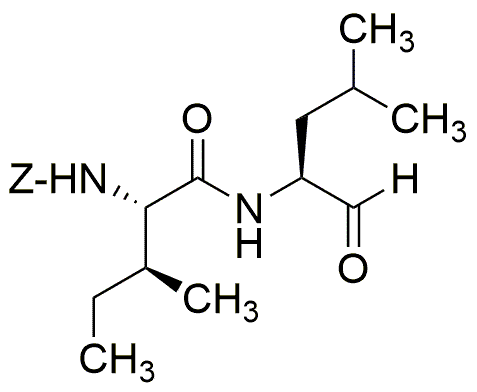Z-Ile-Leu-aldehyde is widely utilized in research focused on:
- Peptide Synthesis: This compound serves as a key intermediate in the synthesis of peptides, particularly in the development of biologically active compounds. Its unique structure allows for the formation of specific peptide bonds, enhancing the efficiency of synthesis processes.
- Drug Development: In pharmaceutical research, Z-Ile-Leu-aldehyde is used to create novel drug candidates. Its ability to mimic natural peptides makes it valuable for designing therapeutics targeting various diseases, including cancer and metabolic disorders.
- Biochemical Studies: Researchers utilize this compound to study enzyme interactions and protein folding. Its role in these processes helps in understanding cellular mechanisms and developing strategies for disease treatment.
- Cosmetic Formulations: The compound is also explored in the cosmetic industry for its potential to enhance skin health. Its properties may contribute to formulations aimed at anti-aging and skin repair.
- Research on Neurotransmitters: Z-Ile-Leu-aldehyde is investigated for its effects on neurotransmitter activity, which could lead to advancements in treatments for neurological disorders, providing insights into brain function and health.
General Information
Properties
Safety and Regulations
Applications
Z-Ile-Leu-aldehyde is widely utilized in research focused on:
- Peptide Synthesis: This compound serves as a key intermediate in the synthesis of peptides, particularly in the development of biologically active compounds. Its unique structure allows for the formation of specific peptide bonds, enhancing the efficiency of synthesis processes.
- Drug Development: In pharmaceutical research, Z-Ile-Leu-aldehyde is used to create novel drug candidates. Its ability to mimic natural peptides makes it valuable for designing therapeutics targeting various diseases, including cancer and metabolic disorders.
- Biochemical Studies: Researchers utilize this compound to study enzyme interactions and protein folding. Its role in these processes helps in understanding cellular mechanisms and developing strategies for disease treatment.
- Cosmetic Formulations: The compound is also explored in the cosmetic industry for its potential to enhance skin health. Its properties may contribute to formulations aimed at anti-aging and skin repair.
- Research on Neurotransmitters: Z-Ile-Leu-aldehyde is investigated for its effects on neurotransmitter activity, which could lead to advancements in treatments for neurological disorders, providing insights into brain function and health.
Documents
Safety Data Sheets (SDS)
The SDS provides comprehensive safety information on handling, storage, and disposal of the product.
Product Specification (PS)
The PS provides a comprehensive breakdown of the product’s properties, including chemical composition, physical state, purity, and storage requirements. It also details acceptable quality ranges and the product's intended applications.
Certificates of Analysis (COA)
Search for Certificates of Analysis (COA) by entering the products Lot Number. Lot and Batch Numbers can be found on a product’s label following the words ‘Lot’ or ‘Batch’.
*Catalog Number
*Lot Number
Certificates Of Origin (COO)
This COO confirms the country where the product was manufactured, and also details the materials and components used in it and whether it is derived from natural, synthetic, or other specific sources. This certificate may be required for customs, trade, and regulatory compliance.
*Catalog Number
*Lot Number
Safety Data Sheets (SDS)
The SDS provides comprehensive safety information on handling, storage, and disposal of the product.
DownloadProduct Specification (PS)
The PS provides a comprehensive breakdown of the product’s properties, including chemical composition, physical state, purity, and storage requirements. It also details acceptable quality ranges and the product's intended applications.
DownloadCertificates of Analysis (COA)
Search for Certificates of Analysis (COA) by entering the products Lot Number. Lot and Batch Numbers can be found on a product’s label following the words ‘Lot’ or ‘Batch’.
*Catalog Number
*Lot Number
Certificates Of Origin (COO)
This COO confirms the country where the product was manufactured, and also details the materials and components used in it and whether it is derived from natural, synthetic, or other specific sources. This certificate may be required for customs, trade, and regulatory compliance.


